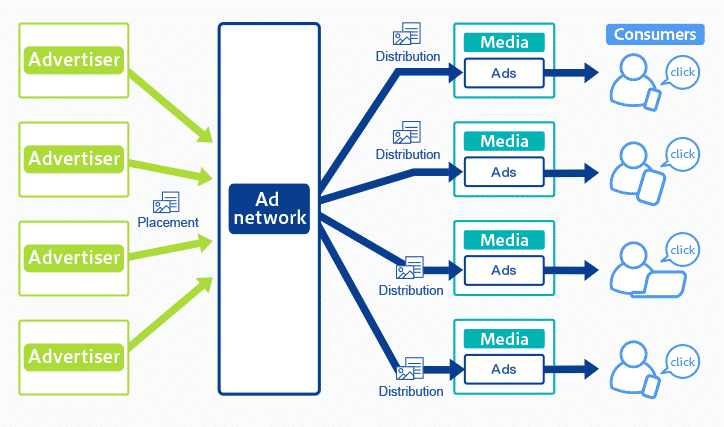
Today, we live in a digital world that is quite different from the one that was a couple of decades ago. Online advertisements are part and parcel of our digital lives, whether we do some research on our work laptop, read a blog on our tablet, or watch a video on our smartphone. Ad placements appear so smooth and well-integrated that as a viewer one often does not realize what goes on behind the scenes.
On the other side of the spectrum, if you are either an advertiser or a publisher, you no longer have to scout for direct deals, spend long hours studying the reach and performance of the publishers or let your ad inventory go to waste. Welcome to the era of ad networks! Once a generic term used for any mode of advertisement, ad networks are now understood to be exclusive to digital marketing.
The easiest way to imagine an ad network is to think of it as a broker between advertisers and publishers. If you look at the statistics, almost half of global ad spends are towards digital ads. This speaks volumes about the importance and relevance of digital ad placements in the current scenario and also the future as trends suggest that digitization will only grow.
An online ad network is a digital platform that intermediates between publishers and advertisers by collecting the available ad inventory from various publishers and selling those to advertisers who are looking to buy such spaces. In other words, ad networks are aggregators for advertisement campaigns and ad inventories with some also providing features for matching publishers and advertisers, tracking ad performance and other metrics.
Ad networks entered the digital space in the mid-90’s when the click-through rates for ads were as high as 40%, unthinkable today! With the entry of Google AdSense in the third millennium, ad networks have become the go to agencies to secure inventory with reputed publishers and get high-value ads for the monetization of websites.

(Source: https://smartyads.com/blog/what-are-ad-networks/)
After coming to grips with the concept of ad networks, the next logical question is ‘how does an ad network work?’ As a transactional platform, ad networks have their fair share of work, as do the advertisers who are interested in placing ads and publishers who want to monetize their digital presence. The steps outlined hereunder briefly introduce the broad tasks that an ad network carries out:

(Source: https://www.fancs.com/en/service/service2)
1. Aggregation of Publishers
For an ad network to be up and running, they must have a wide pool of publishers who are interested in hosting ads. These publishers must have unsold inventory which they hope to sell to buyers (advertisers). The list of publishers should be an active one which grows, and is not stagnant. Each publisher gains access to a personalized dashboard with details of their ad performances and notifications of any ad tags that they have to add to their website.
2. Selection of Ad Inventory by Advertisers
On the part of the advertisers, the ad network provides them with a software to set up campaigns and state their requirements such as budget, target audience, ad frequency, etc. We must remember that any paying advertiser will potentially be scouting for multiple ad networks to get the best deals and reach. This means, the ad network must work hard to attract these advertisers with the quality of publishers on their network and sometimes, premium inventory as their selling point. The advertiser takes the final call on the publisher or multiple publishers to be chosen for any campaign.
3. Matchmaking
Matchmaking is largely automated, if not the advertiser’s call. The matching happens in an auction system where the advertiser has to bid for the premium or unsold inventory of a publisher. Once a match is made, the campaigns begin to be executed. The publishers earn their due mostly as a share of the ad revenue. Depending on the tracking mechanism, the payment is either on the basis of CPC (cost per click), CPM (cost per thousand impressions), CPV (cost per view where the content is a video), or vCPM (viewable cost per thousand impressions.
4. Campaign Management
Campaign management is a big part of the function of an ad network. This is what differentiates their service from direct deals (where you manually have to do all the tracking). The advertiser gets access to a campaign management panel where they can create new campaigns or modify existing ones. Everything from inventory requirement and budget models to targeting and pricing models is accessible here. An ad network offers campaign performance measurement and reporting services as well.
For publishers, the ad network shares the details of the ad after a match is made according to the advertiser’s requirement. Ad networks also automate the process of displaying ad creatives on a website by providing ad tags to the publishers. The ads are auto-fetched from the servers of the ad network, making the process of displaying ads a seamless process for the publisher’s web pages.
It is a misconception to think the direct deals will save you money as a publisher since you can corner all the ad revenue share, or as a publisher since you skip the agency fees. Choosing an ad network for your ad management is much more beneficial to your business than can be quantified in monetary terms. Take a look at some of the advantages of considering an ad network:
For publishers, it is always a headache to get advertisers for their inventory. Even for the top publishers such as news agencies, direct sales only offer about 30% fill rate. In fact, most of the premium ad inventory goes unused if a suitable match is not found. However, when you pick a premium ad network, you ensure an additional 30% fill rate, taking up the score to 60%. Include a remnant ad network to the mix, and the remaining 40% of unsold inventory is taken up in a jiffy, ensuring a 100% fill rate.
For both advertisers and publishers, the wider options offered by an ad network enhance the matching experience as one can focus on a niche and choose based on their criteria instead of pandering to a handful of direct sales options. Even a budget-based search can be initiated by advertisers to find a suitable publisher. On the other hand, publishers find more bidders for their premium and remnant ad inventory.
Elaborate ad networking platforms with multiple digital capabilities allow for targeted search, with options to filter by various factors. The advertiser only has to plug in requirements such as the audience to target, niche, cost, etc. to arrive at a wide array of inventories to place their ads on.
Ad networks have robust IT systems to track the performance of any ad campaign. Study the performance of your ads and the publisher channels you choose, and make informed decisions on your subsequent campaigns. Ad reach and impressions are significantly higher with an ad network as you gain access to the most premium inventories that are in your budget.
For any advertiser, return on investment is an important factor. After all, the ad must result in revenue. With targeted ad placements, a streamlined campaign management process and performance tracking, ROI is seen to increase significantly.
Ad networks are not new, but certainly more relevant now. While Google AdSense comes to the top of every layman’s mind when talking of online ad networks, Propeller Ads, Adcash and DFP are some other strong ad networks today. While one may use several types of digital ad formats such as display ads, native ads and others, the value that an ad network brings cannot be ignored. The mediator between advertisers and publishers, ad networks provide digital services such as matching, campaign creation, ad performance tracking, and even payment management. A good deal for both advertisers and publishers!